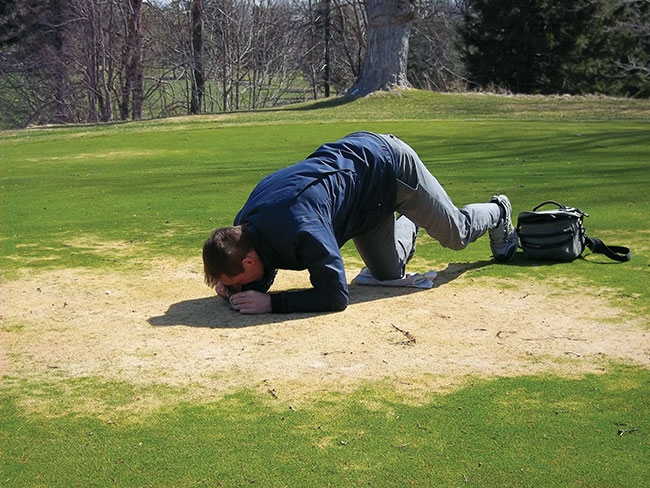
Features
Agronomy
Managing greens in summer extremes
The “spring training” put in helps with the summer “marathon”
March 15, 2019 By Mike Jiggens
 Adam Moeller, education director for the USGA Green Section, takes a closer look at a putting green that suffered winter damage.
Adam Moeller, education director for the USGA Green Section, takes a closer look at a putting green that suffered winter damage. Managing putting greens can be compared to running in a marathon. Golf superintendents must do as much as possible during the spring to “train” for the marathon that is typically “run” in July and August, and sometimes into September.
Adam Moeller, education director for the United States Golf Association’s (USGA) Green Section, used the analogy in January during a presentation he made in Collingwood at the Ontario Golf Superintendents Association’s annual conference.
The “spring training” period is crucial, he said in his address about managing putting greens during extreme weather conditions.
“The rubber really hits the road once we get into those difficult weather conditions in summer.”
A number of critical factors are necessary for maintaining healthy greens, yet superintendents may not have control over all of them. Having the proper growing environment, for example, is critical, but dense tree cover could pose a hindrance. Many club members and owners are reluctant to want to remove trees, thereby reducing the amount of sunlight and air movement the putting greens should receive.
Strategic tree removal will greatly improve growing environments, Moeller said, but added, “It’s much easier said than done.”
Proper drainage is also imperative, especially during heavy rain events. Golf courses ill equipped with good drainage will struggle. Of the two critical factors – a good growing environment and proper drainage – the former is the more important of the two, Moeller said.
“We’ve seen plenty of putting greens, plenty of tees and plenty of fairways that struggle, even though they have excellent drainage, but are located in a tough environment.”
Superintendents can control how they manage their greens and how aggressive they can be doing it, but a balance must be struck between managing healthy turf and keeping greens playable, Moeller said, noting the key elements include mowing, fertilizing, watering and topdressing.
“You need to have that balance with how hard you’re pushing for it to play excellent and how hard you’re making sure you don’t go too far over the edge. We’re not going to suffer some turf loss for the sake of fast greens.”
Weather dictates what a superintendent does over the course of the next three, five or seven days.
“We need to be on our ‘A’ game at all times with water management.”
Moeller said if water isn’t used carefully, there are apt to be consequences. Too much promotes disease while too little encourages wilt. Either way, it leads to complaints among golfers.
“Water management, I think, is the most important thing that we do on a daily basis to keep our grass healthy.”
Proper water management can be challenging for many superintendents who have staffing limitations, Moeller said, adding there is only so much a superintendent, his assistant or whoever is charged with watering is able to do. The more resources a superintendent has, the better he’ll be at managing water by hand, and the benefits will be realized.
Challenge of fertility
Fertility can also present a challenge, Moeller said.
“We need to have a good balance between our fertility program and everything else that impacts growth because if we start to lose control of growth, we’re losing control of clipping yields and losing control of how strong the grass is – the carbohydrate reserves in the plant – and we’re losing control of how we can present the golf course from a playability standpoint.”
Green speeds could register a 10 on the Stimpmeter one day, but the next day control of the greens might be lost and it’s a struggle to get a reading of nine.
Moeller said soils must be managed to ensure optimal organic matter levels are maintained and are diluted with sand topdressing, adding it’s key from both a turf health and playability standpoint. He warned that can be easy to lose sight of when managing golf courses during weather extremes.
Grass species is a necessary consideration when managing greens and striving toward their optimal health. If poa annua greens are being managed to compete against healthy bentgrass greens, playing quality can be equal, but one grass will be stronger and better equipped to withstand different environmental challenges. When entering the heat of summer, a superintendent must look at what he’s seeing with bentgrass populations versus poa populations. Many wish to stress the poa and get more bentgrass rooting on their greens to strike a 50-50 balance of the two.
Moeller said that might look promising in the spring yet when summer arrives and all grasses are struggling, it becomes a challenge to keep one species dominant over the other. It depends on the type of growing environments and how the greens are being managed. In situations where there is 60 to 80 per cent poa cover, “You’ve got to manage those greens that much more carefully.”
Poa still makes for a “fantastic” golf surface, he said, and it can hold up to the best bentgrass greens, but a superintendent must have all of the available resources to manage it. The superintendent with primarily poa greens must have a “shorter leash” and be prepared to “back off” a little bit quicker than his neighbour who has more bentgrass. Although it makes for an ideal putting surface, poa is “finicky” and tricky to manage, Moeller said.
“In summer when we’re managing our greens, poa can go away real quick. Bentgrass will, too. It’s a stronger grass, but that doesn’t imply you should get rid of your poa because it’s weaker. You should just be aware of the need to arm yourself with the necessary resources to properly manage it.”
Seven of the top 10-ranked golf courses in the United States have poa annua greens, but all have the necessary resources to properly manage the annual bluegrass.
Increasing bentgrass populations over time is one way to make greens more reliable and healthier, Moeller said, adding it’s a smart option. But many golf courses purposely choose to manage their poa through resources rather than try to introduce more bentgrass.
When a superintendent is “training for the summer marathon,” he might find the best-laid plans could go by the wayside, Moeller said.
“As turf managers, we react. We change our plans instantly if equipment breaks down, if the weather changes or it someone doesn’t show up for work. We’re constantly fighting this issue.”
Moeller created a scenario for consideration: it’s the second or third week in July and greens are healthy. The superintendent has well managed his greens, he’s adequately staffed, his equipment is in good working order and everything is going smoothly. Suddenly the weather takes a turn for the worse. Temperatures soar into the 30s, humidity levels rise, and ill-timed rain events occur, making for tougher grass-growing conditions.
“What’s the first thing you need to do so that your turf doesn’t suffer the consequences, because you don’t know how long this will last? Mid-July is only the midpoint of the golf season, and there is still a lot of golf to be played.”
He suggested the first thing a superintendent must do is to adjust his expectations and work on adjusting those to whom he reports, such as the club owner or greens committee. The superintendent must say, “The weather is starting to get bad. We have to adjust our programs on our greens.”
Such adjustments might slow them down a little bit, but they’ll remain smooth and true. Firmness might be off a little bit as well because more water will have to be thrown down.
“Mowing and rolling will probably be the first adjustment,” Moeller said, adding alternating between the two practices is recommended. Raising the mowing height is the next logical step. Because the superintendent won’t know how long the stress periods will last, he should begin with alternating between mowing and rolling and then adjusting his mowing height.
Even though the mowing height is being raised, the root system isn’t likely to get any deeper, he said. On the plus side, however, more leaf area is being created for the plant to capture energy and store carbohydrates. Raising the height to perhaps .125 inches could be helpful.
Beyond those strategies, Moeller said mower rollers could be switched up while the next approach might be to target roll around the hole to alleviate as much stress as possible on the remainder of the green. Finally, mowing could be skipped altogether on the short term. He said it’s something even the highest-level golf courses resort to in extreme stress conditions.
“It’s really important to try to anticipate how quickly you need to respond based off of what you’re seeing. No doubt experience will be your best guide. You know how strong your grass is. You know what looks right and what doesn’t look right.”
Superintendents find most of the issues involving their greens are related to summer stress. Moeller said the more experience they gain and the more they understand their golf course and putting greens, the better position they will be to back off in advance of significant stress conditions.
He added the superintendent must have “tough” conversations with his members to let them know when and why green speeds must be reeled in. The superintendent should also meet regularly with the club golf professional because he’s the individual who routinely speaks with golfers.
“Their (the pro’s) lack of turf knowledge is a benefit to them because they talk more easily in the golfer language.”
Moeller created another scenario: it’s mid-July, temperatures have been hot and a half-inch rain event has just occurred. Temperatures spike back up in the afternoon, closing in on 30 degrees. In this scenario, moisture meters are a valuable tool to have on hand, he said.
“Too much water is more lethal than too little. So less is more.”
He suggested everyone with a hose in his hand should have a moisture meter in the other to determine how much water needs to go into the soil. Depending on how well a golf course is staffed and how often maintenance workers can be dispatched to their greens, syringing can take place once an hour, from about noon until 7 p.m.
It’s during the heat of the summer when superintendents earn their salaries, Moeller said.
Good air movement is vital to keeping greens healthy, he said, adding if trees are preventing proper air circulation, then fans should be considered.
“In the heat of the summer – during the stress period – fans, I think, are more important than sunlight.”
Sunlight is still crucial, he said, but fans are second to none during the months of July and August. Fans have a downside, however. They can be costly, and many golf courses find they are noisy and an intrusion to the property’s aesthetics. Moeller said those critical of the cost of fans should know the alternative might be an increase in dollar spot applications, suggesting fans are a long-term infrastructure improvement.
“There’s no question they improve turf quality,” he said, adding it’s better to run fans 24 hours a day than simply during daytime hours. A Rutgers University study showed better root development when fans ran constantly rather than just during the day. Turf roots benefit not only from the round-the-clock operation of the fan, but from the natural cooling during the evening.
Print this page
